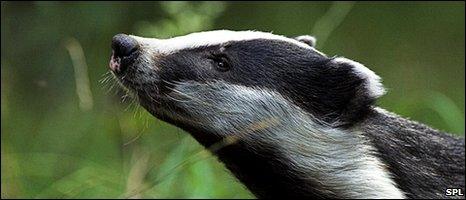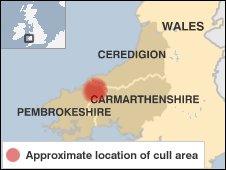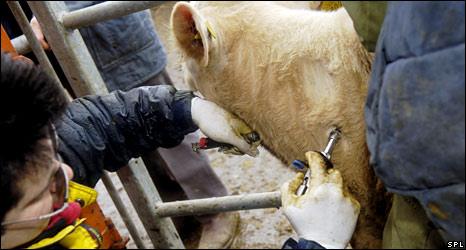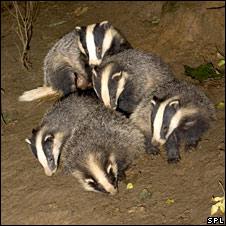Badger culling: Questions and answers
- Published
A pilot cull of badgers is about to start in Wales with the aim of curbing tuberculosis in cattle; and the UK government has indicated that culling may begin in England too in the next few years.
Our environment correspondent Richard Black looks at what is happening, and what it may achieve.

What is happening in Wales?
The Welsh Assembly Government (WAG) is commissioning a pilot cull of badgers within a 288 sq km (111 sq miles) area of south-west Wales.
WAG has not revealed the date when the cull will begin, nor the exact boundaries of the Intensive Action Pilot Area; but it is known to lie principally in north Pembrokeshire, extending marginally into Ceredigion and Carmarthenshire.

The aim is to remove all badgers within the area.
Animals will be trapped in cages and shot, although the control order also allows for the shooting of roaming badgers and for the use of lethal injection.
The order gives contractors the right to enter anyone's land. A minority of landowners have declared their opposition.
The pilot cull is expected to last for five years. It is part of a wider programme of efforts to control the disease in the area, which will also see cattle being tested for infection twice each year in addition to existing restrictions on their movements.
At least 1,500 badgers are likely to be killed during the pilot.
Why is it happening?
Infection through contact with badgers is one of the main routes by which cattle contract bovine tuberculosis (though nationally, cattle-to-cattle transmission is more significant).
This debilitating disease is caused by Mycobacterium bovis, a close relative of the bacterium that usually causes TB in humans.
Because the bovine bacterium can also cause human TB, infected cattle have to be destroyed.
The incidence of the disease has been growing in Wales. WAG says that more than 12,000 cattle were slaughtered as a result of TB infection in 2008 (compared with 669 in 1997), at a cost of £24m to the public purse.

The Welsh plan also involves an increase in cattle screening to detect infection
In March 2009, Rural Affairs Minister Elin Jones announced that a pilot badger cull would be instigated. North Pembrokeshire was chosen largely because TB is an acute problem there, with more than half the compensation paid out across Wales going to farmers in this area.
Based on existing scientific research, WAG believes the cull may reduce the incidence of TB in cattle by 9%, with the effect persisting for 2 to 3 years after the cull stops.
The ultimate aim of the entire intensive bovine TB plan - culling plus all the cattle control measures - is local eradication of the disease.
How much will it cost?
WAG has allocated £9m over the five-year period to intensive bovine TB controls within the North Pembrokeshire area, including culling.
This does not include the cost of any policing operations.
WAG's advisory documents put the culling cost at £2,830 per badger.
It believes that given the high and rising cost of the disease in cattle, this is an investment that should pay for itself.
Is culling backed by science?
The biggest study on the issue anywhere in the world - the UK Randomised Badger Culling Trial (RBCT), also known as the "Krebs Trial" - concluded that "reactive culling" (killing badgers in response to a TB outbreak in cattle) makes the problem worse, producing an increase in infections in cattle.
This is thought to be because culling disturbs badgers' social groups, causing them to roam further and come into contact with more cattle.
Culling "proactively" - seeking to wipe out badgers in pre-determined areas, as will be done in the Welsh pilot - brought the infection rate down within the culled area.
However, it also produced an increase in infection on farms outside the immediate area - again, probably because the badgers were roaming further afield.
In early 2007, the government's advisers, the Independent Scientific Group, which included the scientific leaders of the Krebs Trial, concluded that culling "cannot meaningfully contribute to the future control of cattle TB in Britain".
They said culling was unlikely to have a significant positive impact unless conducted over really big areas, and would not be cost-effective. The rising tide of infection could be tackled by cattle-based measures, they said.
Soon afterwards, a review by the then UK chief scientific adviser Sir David King reached the opposite conclusion: culling could be an useful tool under certain situations, he determined. His analysis did not include the question of cost effectiveness.
Sir David was heavily criticised within the scientific community, an editorial in the journal Nature saying his "mishandling" of the issue "…is an example to governments of how not deal with [independent scientific] advice".
Badgers are culled in the Irish Republic, where the government says it makes a real contribution to suppressing bovine TB, but will not eradicate the disease. In New Zealand, possums are culled for the same reason.
Is it legal?
The European badger (Meles meles) is a protected species under both the European Bern Convention of 1979 and the UK's 1992 Protection of Badgers Act.
However, both of these documents allow for exemptions "to prevent serious damage to crops, livestock, forests, fisheries, water and other forms of property", provided "there is no other satisfactory solution and that the exception will not be detrimental to the survival of the (wildlife) population concerned".

Badgers are protected under European and UK law
In addition, the UK's Animal Health Act of 1981 sets out conditions under which the designated government minister can order a cull.
The minister must be satisfied that a wildlife species is acting as a reservoir of an animal disease, and "that destruction of wild members of that or those species in that area is necessary in order to eliminate, or substantially reduce the incidence of, that disease in animals of any kind in the area", then he or she may "by order provide for the destruction of wild members of that or those species in that area".
Both UK laws, and the Bern Convention, apply in Wales.
Last year, the Badger Trust lodged application for a judicial review of the cull order.
Its main grounds were that culling would not "substantially reduce" TB incidence, that the minister had erroneously proceeded on the basis (contrary to her scientific evidence) that the benefit would persist for years after culling stopped, and that the minister had failed to balance the harm to badgers against the suggested benefits for cattle.
The judicial review found in favour of WAG.
However, in early June the Badger Trust won leave to appeal against that decision in the Court of Appeal. No date has yet been set.
What about vaccination?
Current regulations mean that vaccinated cattle could not be exported to the rest of the EU, as current tests cannot distinguish between infected and vaccinated animals.
Vaccinating badgers is another approach. The effectiveness of injectable vaccines has been shown in captive badgers, but has not yet been demonstrated in the wild.
The ultimate goal is an oral vaccine that would be added to food left out for badgers to eat. This may be available in four to five years' time.
The Irish Republic sees vaccination as opening the door to eradication of bovine TB. However, vaccines would not affect infected badgers, so culling might be maintained for some years after the start of a vaccination programme.
What does the Welsh plan mean for the rest of the UK?
The coalition government in Westminster (which administers the issue for England) says it will "introduce a carefully managed and science-led policy of badger control in areas with high and persistent levels of bovine tuberculosis".
In briefings in May, Environment Secretary Caroline Spelman said this could include limited culling in "hot-spots". But Agriculture Minister James Paice took a considerably stronger line, telling farmers: "We will do it - it is an absolute pledge".
Opponents have asked how small-scale targeted culls can be "science-based" when the Krebs Trial conclusions indicate that only large-scale culls can produce a positive impact. Ms Spelman says the situation has changed since 2005, when the Krebs Trial concluded.
Ms Spelman said her department would look to learn from the Welsh experience. This would not mean waiting for results, however, but observing how contractors carry out the process.
Northern Ireland's agriculture department does not have plans for a cull but, says it "shall be very interested to see exactly what it is they (Defra) propose and how it is to be funded".
The Scottish government has no plans in the area, as it says badgers are not a source of bovine TB infection in Scotland.
- Published4 June 2010
- Published1 June 2010